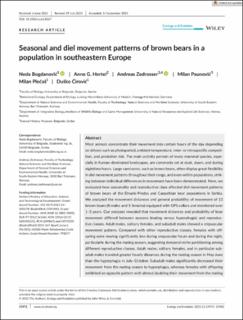| dc.contributor.author | Bogdanović, Neda | |
| dc.contributor.author | Hertel, Anne G. | |
| dc.contributor.author | Zedrosser, Andreas | |
| dc.contributor.author | Paunović, Milan | |
| dc.contributor.author | Plećaš, Milan | |
| dc.contributor.author | Ćirović, Duško | |
| dc.date.accessioned | 2022-03-21T11:16:01Z | |
| dc.date.available | 2022-03-21T11:16:01Z | |
| dc.date.created | 2021-12-27T19:20:05Z | |
| dc.date.issued | 2021 | |
| dc.identifier.citation | Bogdanović, N., Hertel, A. G., Zedrosser, A., Paunović, M., Plećaš, M. & Ćirović, D. (2021). Seasonal and diel movement patterns of brown bears in a population in southeastern Europe. Ecology and Evolution, 11(22), 15972-15983. | en_US |
| dc.identifier.issn | 2045-7758 | |
| dc.identifier.uri | https://hdl.handle.net/11250/2986421 | |
| dc.description.abstract | Most animals concentrate their movement into certain hours of the day depending on drivers such as photoperiod, ambient temperature, inter- or intraspecific competition, and predation risk. The main activity periods of many mammal species, especially in human-dominated landscapes, are commonly set at dusk, dawn, and during nighttime hours. Large carnivores, such as brown bears, often display great flexibility in diel movement patterns throughout their range, and even within populations, striking between individual differences in movement have been demonstrated. Here, we evaluated how seasonality and reproductive class affected diel movement patterns of brown bears of the Dinaric-Pindos and Carpathian bear populations in Serbia. We analyzed the movement distances and general probability of movement of 13 brown bears (8 males and 5 females) equipped with GPS collars and monitored over 1–3 years. Our analyses revealed that movement distances and probability of bear movement differed between seasons (mating versus hyperphagia) and reproductive classes. Adult males, solitary females, and subadult males showed a crepuscular movement pattern. Compared with other reproductive classes, females with offspring were moving significantly less during crepuscular hours and during the night, particularly during the mating season, suggesting temporal niche partitioning among different reproductive classes. Adult males, solitary females, and in particular subadult males traveled greater hourly distances during the mating season in May-June than the hyperphagia in July–October. Subadult males significantly decreased their movement from the mating season to hyperphagia, whereas females with offspring exhibited an opposite pattern with almost doubling their movement from the mating to hyperphagia season. Our results provide insights into how seasonality and reproductive class drive intrapopulation differences in movement distances and probability of movement in a recovering, to date little studied, brown bear population in southeastern Europe. | en_US |
| dc.language.iso | eng | en_US |
| dc.rights | Navngivelse 4.0 Internasjonal | * |
| dc.rights.uri | http://creativecommons.org/licenses/by/4.0/deed.no | * |
| dc.title | Seasonal and diel movement patterns of brown bears in a population in southeastern Europe | en_US |
| dc.type | Peer reviewed | en_US |
| dc.type | Journal article | en_US |
| dc.description.version | publishedVersion | en_US |
| dc.rights.holder | © 2021 The Authors. | en_US |
| dc.source.pagenumber | 15972-15983 | en_US |
| dc.source.volume | 11 | en_US |
| dc.source.journal | Ecology and Evolution | en_US |
| dc.source.issue | 22 | en_US |
| dc.identifier.doi | https://doi.org/10.1002/ece3.8267 | |
| dc.identifier.cristin | 1972307 | |
| cristin.ispublished | true | |
| cristin.fulltext | original | |
| cristin.qualitycode | 1 | |

